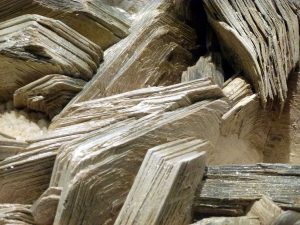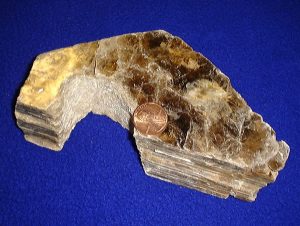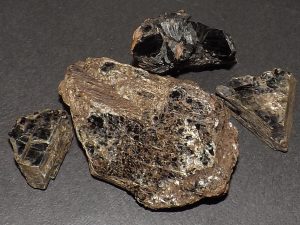


The mica group of sheet silicate (phyllosilicate) minerals includes several closely related materials having nearly perfect basal cleavage. All are monoclinic, with a tendency towards pseudohexagonal crystals, and are similar in chemical composition. The nearly perfect cleavage, which is the most prominent characteristic of mica, is explained by the hexagonal sheet-like arrangement of its atoms.
The word mica is derived from the Latin word mica , meaning a crumb, and probably influenced by micare , to glitter.




Chemically, micas can be given the general formula
X is K, Na, or Ca or less commonly Ba, Rb, or Cs; Y is Al, Mg, or Fe or less commonly Mn, Cr, Ti, Li, etc.; Z is chiefly Si or Al, but also may include Fe 3+ or Ti.
Structurally, micas can be classed as dioctahedral (Y = 4) and trioctahedral (Y = 6). If the X ion is K or Na, the mica is a common mica, whereas if the X ion is Ca, the mica is classed as a brittle mica.
Very fine-grained micas, which typically show more variation in ion and water content, are informally termed “clay micas”. They include:
Mica is widely distributed and occurs in igneous, metamorphic and sedimentary regimes. Large crystals of mica used for various applications are typically mined from granitic pegmatites.
Until the 19th century, large crystals of mica were quite rare and expensive as a result of the limited supply in Europe. However, their price dramatically dropped when large reserves were found and mined in Africa and South America during the early 19th century. The largest documented single crystal of mica (phlogopite) was found in Lacey Mine, Ontario, Canada; it measured 10 m × 4.3 m × 4.3 m (33 ft × 14 ft × 14 ft) and weighed about 330 tonnes (320 long tons; 360 short tons). Similar-sized crystals were also found in Karelia, Russia.
The British Geological Survey reported that as of 2005, Koderma district in Jharkhand state in India had the largest deposits of mica in the world. China was the top producer of mica with almost a third of the global share, closely followed by the US, South Korea and Canada. Large deposits of sheet mica were mined in New England from the 19th century to the 1970s. Large mines existed in Connecticut, New Hampshire, and Maine.
Scrap and flake mica is produced all over the world. In 2010, the major producers were Russia (100,000 tonnes), Finland (68,000 t), United States (53,000 t), South Korea (50,000 t), France (20,000 t) and Canada (15,000 t). The total global production was 350,000 t, although no reliable data were available for China. Most sheet mica was produced in India (3,500 t) and Russia (1,500 t). Flake mica comes from several sources: the metamorphic rock called schist as a byproduct of processing feldspar and kaolin resources, from placer deposits, and from pegmatites. Sheet mica is considerably less abundant than flake and scrap mica, and is occasionally recovered from mining scrap and flake mica. The most important sources of sheet mica are pegmatite deposits. Sheet mica prices vary with grade and can range from less than $1 per kilogram for low-quality mica to more than $2,000 per kilogram for the highest quality.
The mica group represents 37 phyllosilicate minerals that have a layered or platy texture. The commercially important micas are muscovite and phlogopite, which are used in a variety of applications. Mica’s value is based on several of its unique physical properties. The crystalline structure of mica forms layers that can be split or delaminated into thin sheets usually causing foliation in rocks. These sheets are chemically inert, dielectric, elastic, flexible, hydrophilic, insulating, lightweight, platy, reflective, refractive, resilient, and range in opacity from transparent to opaque. Mica is stable when exposed to electricity, light, moisture, and extreme temperatures. It has superior electrical properties as an insulator and as a dielectric, and can support an electrostatic field while dissipating minimal energy in the form of heat; it can be split very thin (0.025 to 0.125 millimeters or thinner) while maintaining its electrical properties, has a high dielectric breakdown, is thermally stable to 500 °C (932 °F), and is resistant to corona discharge. Muscovite, the principal mica used by the electrical industry, is used in capacitors that are ideal for high frequency and radio frequency. Phlogopite mica remains stable at higher temperatures (to 900 °C (1,650 °F)) and is used in applications in which a combination of high-heat stability and electrical properties is required. Muscovite and phlogopite are used in sheet and ground forms.
The leading use of dry-ground mica in the US is in the joint compound for filling and finishing seams and blemishes in gypsum wallboard (drywall). The mica acts as a filler and extender, provides a smooth consistency, improves the workability of the compound, and provides resistance to cracking. In 2008, joint compound accounted for 54% of dry-ground mica consumption. In the paint industry, ground mica is used as a pigment extender that also facilitates suspension, reduces chalking, prevents shrinking and shearing of the paint film increases the resistance of the paint film to water penetration and weathering and brightens the tone of colored pigments. Mica also promotes paint adhesion in aqueous and oleoresinous formulations. Consumption of dry-ground mica in paint, the second-ranked use, accounted for 22% of the dry-ground mica used in 2008.
Ground mica is used in the well-drilling industry as an additive to drilling fluids. The coarsely ground mica flakes help prevent the loss of circulation by sealing porous sections of the drill hole. Well drilling muds accounted for 15% of dry-ground mica use in 2008. The plastics industry used dry-ground mica as an extender and filler, especially in parts for automobiles as lightweight insulation to suppress sound and vibration. Mica is used in plastic automobile fascia and fenders as a reinforcing material, providing improved mechanical properties and increased dimensional stability, stiffness, and strength. Mica-reinforced plastics also have high-heat dimensional stability, reduced warpage, and the best surface properties of any filled plastic composite. In 2008, consumption of dry-ground mica in plastic applications accounted for 2% of the market. The rubber industry used ground mica as an inert filler and mold release compound in the manufacture of molded rubber products such as tires and roofing. The platy texture acts as an anti-blocking, anti-sticking agent. Rubber mold lubricant accounted for 1.5% of the dry-ground mica used in 2008. As a rubber additive, mica reduces gas permeation and improves resiliency.
Dry-ground mica is used in the production of rolled roofing and asphalt shingles, where it serves as a surface coating to prevent sticking of adjacent surfaces. The coating is not absorbed by freshly manufactured roofing because mica’s platy structure is unaffected by the acid in asphalt or by weather conditions. Mica is used in decorative coatings on wallpaper, concrete, stucco, and tile surfaces. It also is used as an ingredient in flux coatings on welding rods, in some special greases, and as coatings for core and mold release compounds, facing agents, and mold washes in foundry applications. Dry-ground phlogopite mica is used in automotive brake linings and clutch plates to reduce noise and vibration (asbestos substitute); as sound-absorbing insulation for coatings and polymer systems; in reinforcing additives for polymers to increase strength and stiffness and to improve stability to heat, chemicals, and ultraviolet (UV) radiation; in heat shields and temperature insulation; in industrial coating additive to decrease the permeability of moisture and hydrocarbons; and in polar polymer formulations to increase the strength of epoxies, nylons, and polyesters.
Wet-ground mica, which retains the brilliance of its cleavage faces, is used primarily in pearlescent paints by the automotive industry. Many metallic-looking pigments are composed of a substrate of mica coated with another mineral, usually titanium dioxide (TiO2). The resultant pigment produces a reflective color depending on the thickness of the coating. These products are used to produce automobile paint, shimmery plastic containers, high-quality inks used in advertising and security applications. In the cosmetics industry, its reflective and refractive properties make mica an important ingredient in blushes, eye liner, eye shadow, foundation, hair and body glitter, lipstick, lip gloss, mascara, moisturizing lotions, and nail polish. Some brands of toothpaste include powdered white mica. This acts as a mild abrasive to aid polishing of the tooth surface, and also adds a cosmetically pleasing, glittery shimmer to the paste. Mica is added to latex balloons to provide a colored shiny surface.
Mica is also used as an insulator in concrete block and home attics and can be poured into walls (usually in retrofitting uninsulated open top walls). Mica may also be used as a soil conditioner, especially in potting soil mixes and in gardening plots. Greases used for axles are composed of a compound of fatty oils to which mica, tar or graphite is added to increase the durability of the grease and give it a better surface.